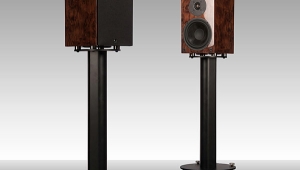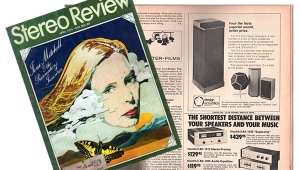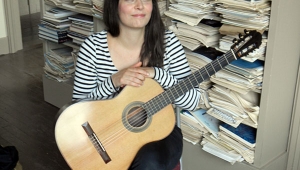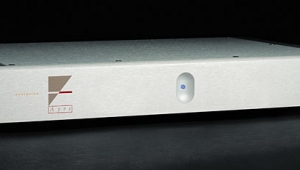| Columns Retired Columns & Blogs |
The Fifth Element #37
While you might have been paying attention to other matters, there has been a quiet revolution in affordable recording technology. What if I told you that I've been making pure Direct Stream Digital (DSD), SACD-quality two-channel recordings using equipment that, from soup to nuts, costs less than $6000? Read on.
Footnote 1: I am grateful to Jerry Bruck, of New York City's Posthorn Recordings, for his constructive criticism of a draft of this column.

I last covered recording equipment in "The Fifth Element" in the August 2002 issue (Vol.25 No.8). That column remains the best place to start if you're just getting going. This column reports on some spiffy new equipment I've been working and playing with over the past few months (footnote 1).
I begin with a microphone preamplifier that is remarkably, perhaps even uniquely, versatile: the True Systems P2analog ($1999, frequently discounted). The P2analog is designed to be equally at home in a project studio and on the road, doing live-to-two-track recordings. It has three features not usually found in two-channel microphone preamplifiers: two direct inputs (DIs), for instruments such as electric guitar, bass, or keyboards; Mid-Side (M-S) microphone matrixing; and an absolutely hypnotic stereo phase indicator.
I passed over the DIs, because I have never done that kind of recording. Based on the performance of the rest of the P2, I assume that they are fine. I used the M-S matrix function at every opportunity and enjoyed it immensely. And I couldn't stop watching the stereo indicator.
Because M-S microphone technique is far less well known than it should be, some theoretical background is in order (footnote 2). Fear not; this will be painless and enlightening.
A brief history of putting microphones in front of things
The intuitive way to make a two-channel stereo recording is to point, in some manner, one of two identical microphones at the left side of the soundstage, the other at the right side. I say "in some manner" because there are, generally speaking, three ways to arrange two microphones for stereo recording: coincident, near-coincident, and spaced.
In a coincident microphone array, the two mike capsules are as close together as possible, usually one above the other, so that no arrival-time/phase anomalies are created by horizontal offset. Because the directional axes of the two mike capsules intersect, the coincident technique is usually referred to as the X-Y technique, after the axes on a mathematical graph.
For microphones that look like typical modern mikes (ie(, are shaped like flashlights), the capsules are vertically overlapped, the right-hand mike pointing left, the left-hand mike pointing right, somewhat like an inverted V. The capsules are arranged at 90° or more to each other, preferably as much as 110° or 120° (footnote 3). (The Audio-Technica mike I recommended in 2002, the AT-825, is a single-point, 110°, X-Y two-channel stereo microphone array in a single housing.)
Microphones that look like old RCA broadcast mikes or their progeny are meant to be used in an upright position, and for that reason are called side-address microphones. Coincident placement of two side-address mikes requires a special mounting bracket that holds one mike upside-down directly above the other, and which provides that the horizontal angle between them can be adjusted to 90° or more, as the case may require.
Near-coincident arrays include ORTF (named after the early French TV network) and any other pattern that places the capsules of the stereo pair a foot or less apart. Such techniques often depend on their capsules' placements mimicking the intra-aural distance; that is, the average distance between an adult human being's eardrums, which is roughly 7" (18cm).
In the ORTF technique, two cardioid mikes are placed 7" apart and angled outward 110°. Dutch (NOS) and Swiss (OSS) broadcasters developed other near-coincident schemes. The Dutch scheme actually predated ORTF, but after the Dutch tried the ORTF technique, they discarded NOS and thereafter used ORTF.
The Swiss OSS technique is better known as the Jecklin Disc. In that arrangement, a circular acoustical baffle approximately 1' in diameter is positioned between the microphones, which themselves are 7" apart. This enhances lateral localization for the higher frequencies, because the disc attenuates a certain amount of the high-frequency sounds the farther-away mike would otherwise receive from off-center sound sources. Yet because the mikes used are omnidirectional, the lower-midrange and bass responses remain robust. The Jecklin Disc is at least the spiritual ancestor of Ray Kimber's Iso-Mike array—which John Atkinson detailed in his report on Robert Silverman's recording sessions for Beethoven's Diabelli Variations (May 2006, Vol.29 No.5)—as well as of Schoeps' KFM-6 sphere microphone.
If an array is neither coincident nor near-coincident, then it is spaced. Spaced arrays are generally referred to as A-B techniques, as in Microphone A and Microphone B. Spacing is usually anything between 3' and 10'—or even more—depending on the size of the ensemble to be recorded. A-B technique usually uses omnidirectional mikes, although figure-8 or cardioid-pattern models are sometimes used. The spaced-omni technique has a long and honorable history; most of Telarc's classical recordings having been made with the label's own variant of it.
With so many microphone techniques, each having an at least plausible story to tell, one might be moved to ask: Why does the world need one more, distinctly nonintuitive technique; namely, M-S? Because, in practical use, each "intuitive" microphone technique has a drawback that is the mirror image of its strongest selling point. (In the following descriptions of these problems, I speak in broad-brush generalizations. Great recordings have been made using just about every technique under the sun, including techniques that blithely ignore the laws of physics. Conversely, use of a high-zoot technique does not guarantee that the result will be worth listening to as music. We are in, after all, the realm of aesthetics. I can imagine someone taking issue with Anselm Kiefer over his art, but not over the brand of paint he buys.)
Spaced omnis give you a huge room sound, yet the specificity of center images can be somewhat vague. This is why Telarc's usual practice, which itself is a derivative of Bell Labs' technique, has been to use a centrally located omni mike bled into the left and right channels in order to firm up the center image. The "Decca Tree" is another such effort. By contrast, coincident techniques give great image specificity, but at the risk of a certain lack of the feeling of spaciousness. Near-coincident techniques can be an attractive compromise, giving more "air" or spaciousness than coincident placement, while having more specificity than spaced arrays. However, to use something like ORTF on a solo instrument such as classical guitar means that both microphone capsules are off-axis to the sound source by nearly 60°.
Would you photograph something to the north of you by aiming one camera west-northwest and another east-northeast? Of course not. It is not only a matter of filling the frame, so to speak. Most microphone capsules are most linear in frequency response for sources directly in front of them, and become less so the more off-axis they are to the sound source.
Mid-Side to the rescue. As nonintuitive a technique as one could ask for, M-S points one microphone directly at the sound source, the other 90° away from it. M-S usually uses two dissimilar microphones, one of which always must be a side-facing figure-8. (Figure-8 mikes are so called because their polar response or directivity looks like a figure 8, with a positive lobe to the front and a negative lobe to the rear.) The forward-facing Mid mike is usually a directional model such as a cardioid, although another figure-8 or even an omnidirectional mike can also be used. The Mid mike, in and of itself, being totally on-axis to the sound source, is as tonally true as possible, and also would give a completely solid center image. The problem is that that image would be monophonic, with no stereo information.
So here is M-S's cute trick. The Side-facing microphone picks up ambient information from the left side of the recording venue on its positive lobe (the "front" of the mike), while its rear-facing negative lobe picks up ambient information from the right side of the recording venue. By splitting the output of the Side mike in two and blending it in and out of phase with the output of the Mid mike, the M-S matrix derives Left and Right channels from a "virtual" microphone pair (assuming a cardioid Mid mike) of angled X-Y directional mikes. Mid plus Side equals Left, Mid plus phase-inverted Side equals Right.
Footnote 1: I am grateful to Jerry Bruck, of New York City's Posthorn Recordings, for his constructive criticism of a draft of this column.
Footnote 2: The scarcity of dedicated M-S–capable equipment is only part of the problem. Other than True Systems' P2analog, I know only of Grace Design's Lunatec V3 portable combination mike preamp and A/D converter, and a portable mike preamp from Schoeps. AEA's standalone line-level (non–mike preamp) M-S matrix has fallen out of production, sad to say. On the good-news front, Sound Devices' hard-disk–based portable recorders include M-S matrixing. But the lack of dedicated M-S equipment is not as big a drawback as one might think: The necessary splitting, phase-inversion, and level adjustments of raw M-S tracks can be accomplished in postproduction on any fully featured mixing board or digital audio workstation.
Footnote 3: Mathematically, a coincident pair of cardioids angled at 90° gives just 6dB separation for soundsources at the left and right positions—"fat mono"—which can be increased by increasing the included angle.—John Atkinson
- Log in or register to post comments




































